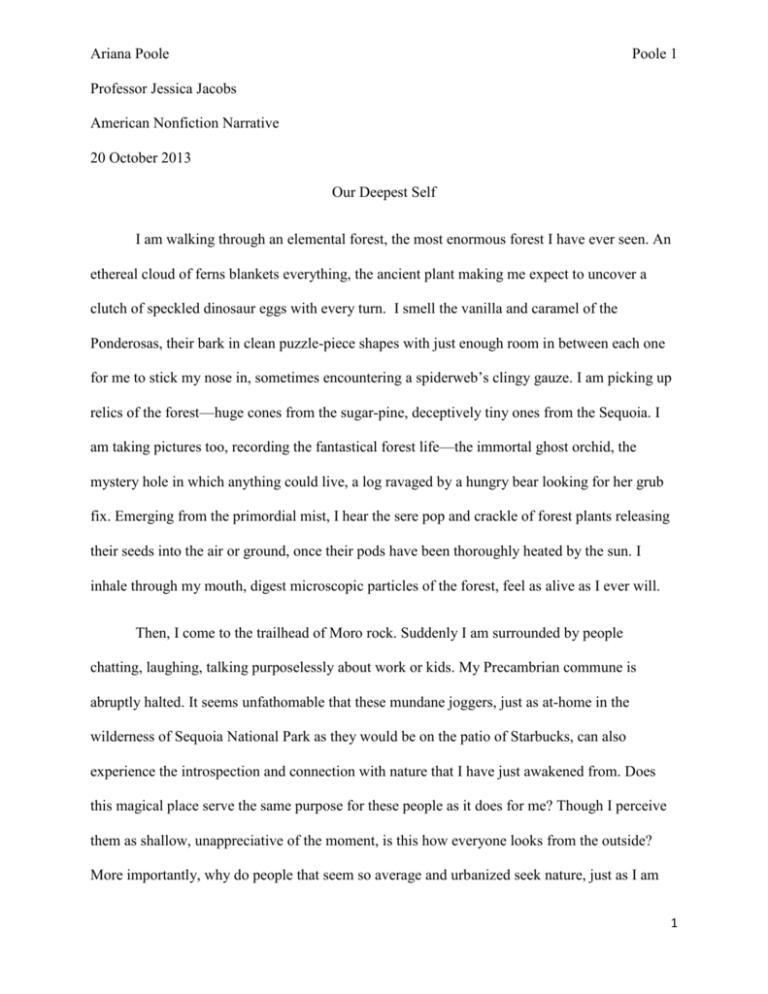Ana Poole - J. Jacobs: Courses
advertisement

Ariana Poole Poole 1 Professor Jessica Jacobs American Nonfiction Narrative 20 October 2013 Our Deepest Self I am walking through an elemental forest, the most enormous forest I have ever seen. An ethereal cloud of ferns blankets everything, the ancient plant making me expect to uncover a clutch of speckled dinosaur eggs with every turn. I smell the vanilla and caramel of the Ponderosas, their bark in clean puzzle-piece shapes with just enough room in between each one for me to stick my nose in, sometimes encountering a spiderweb’s clingy gauze. I am picking up relics of the forest—huge cones from the sugar-pine, deceptively tiny ones from the Sequoia. I am taking pictures too, recording the fantastical forest life—the immortal ghost orchid, the mystery hole in which anything could live, a log ravaged by a hungry bear looking for her grub fix. Emerging from the primordial mist, I hear the sere pop and crackle of forest plants releasing their seeds into the air or ground, once their pods have been thoroughly heated by the sun. I inhale through my mouth, digest microscopic particles of the forest, feel as alive as I ever will. Then, I come to the trailhead of Moro rock. Suddenly I am surrounded by people chatting, laughing, talking purposelessly about work or kids. My Precambrian commune is abruptly halted. It seems unfathomable that these mundane joggers, just as at-home in the wilderness of Sequoia National Park as they would be on the patio of Starbucks, can also experience the introspection and connection with nature that I have just awakened from. Does this magical place serve the same purpose for these people as it does for me? Though I perceive them as shallow, unappreciative of the moment, is this how everyone looks from the outside? More importantly, why do people that seem so average and urbanized seek nature, just as I am 1 Ariana Poole Poole 2 Professor Jessica Jacobs American Nonfiction Narrative 20 October 2013 doing? Why do they obviously put themselves through physical discomfort—through activities that are not suited for anyone disabled, above a certain age, or with a certain percentage of bodily fat? What do people gain from a simple hike up and down a rock, and is the gain similar or different from that of others? With every person that I pass on my advance up the first boulder, these questions are renewed, playing consistently in my head in time with my labored breath. The Sierra Nevadas, being a relatively new mountain range, jut from earth like teeth from the gaping maw of Charybdis. Icy rivers cascade through deep valleys and smooth the boulderbones of old glaciers. Millions of years ago, during the Cretaceous Period, this area was an underwater seam in the patchwork of plate tectonics, one plate crumpling and subducting under the advance of another (Resendes). During this process, water became superheated, due to its close proximity with the earth’s mantle, and gushed upward, melting rock as it went. This molten rock cooled beneath many layers of the earth’s surface, forming a pocket of igneous rock— granite, diorite, or monzonite depending on what kind of mineral deposits were contained in each (naturescience/geology_overview.htm). The pocket, known as a batholith, was then the skeleton of the Sierras, covered by a layer of sedimentary rock formed as the shells and bones of marine life accrued on the ocean floor. As the batholith began to rise, the mass grave of a million primordial sea creatures was gradually eroded away, coming to rest in the valleys or at the bottoms of forgotten streams, though the rare deposit of nautilus or ammonite fossils—called roof pendants—can still be found on some of the tallest peaks. 2 Ariana Poole Poole 3 Professor Jessica Jacobs American Nonfiction Narrative 20 October 2013 Slightly more recently (in geologic terms), glaciers made their stately way up the west coast, gutting the land into valleys that contrasted even more with the rugged vista and leaving behind disconcertingly smooth moraines (Resendes). Since before the time of Columbus, the same ancient Sequoias have rooted on the lower and middle slopes of the Sierras, along with their less massive coniferous peers. Red fir and lodgepole pine dominate the upper slopes, while the topmost scarps bear only the bleak majesty of pure rock (naturescience/plants.htm). The range is mostly composed of granite, gray at a distance but speckled with secretly glimmering flecks of quartz, mica, and feldspar when truly examined. The tectonic forces always present in any mountain range have metamorphosed some granite in the roots of the mountains into marble, creating beautifully polished caves that furtively boast capricious formations and bizarre wildlife. Negotiating around an Asian family immersed in the composition of their vacation photo, I approach for the first time the initial step in the trail to the peak of Moro rock. The rock, a bare promontory that protrudes like an escaped bone of the mountainside, looks down onto the Great Western Divide, a majestic string of peaks that marks the separation between the watersheds of the westward-flowing Kaweah River and the southward-flowing Kern (Archive for Great Western Divide). It is composed of granite like its fellow, less accessible peaks, which are visible in the higher strata where the fuzzy green of the pines peters out into jagged gray crags. Massive boulders ring the start of the trail, piling up on each other at the base of the precipice. I glimpse a lizard performing ritual mating-call push-ups, flashing his iridescent underside to any females who might be interested, as well as demonstrating his virility to his 3 Ariana Poole Poole 4 Professor Jessica Jacobs American Nonfiction Narrative 20 October 2013 peers and competitors. An overhanging boulder encroaches on the path, bringing with it a sense of understandable unease. On its belly, unnervingly close to my head, there is a shell of neon lichen, found in all the same colors as the racks of clothing at Forever 21, but infinitely far from the world of human fabrication. My feet crunch through gravel at the level parts, pound man- and mountain-made stairs at the steep ones. I gaze over the side into a dizzying chasm, the broad river only visible as a silver trickle in the blurry depths, take a small step away from the single line of ankle-high flagstones that is the only barrier between my body and this void. The flow of people is slightly less condensed at the higher elevation, but still prevalent enough to give me split-second nightmares about falling to my death, wheeling among the ravens and hawks that casually approach now that we share an altitude. I pass a group, a family speaking Spanish, the mother quietly reasoning with the child that keeps repeating “no quiero caminar.” To my side, a robust father claps his son on the shoulder and affirms that they will “beat” this mountain. Why is there such adversity in the relationship between modern humans and nature? As my hike progresses, I hear language like “conquer,” “beat,” and “kill”—all applying to the speaker vs. the climb. Even though this is a conscious choice the person made, he or she still sees the situation as a sort of fight in which they must come out on top. Human history, I find, is essentially a tale of increasingly manipulating the nature around us to best serve our purposes. In the case of many native tribes (of various continents), and even some modern-day locally based farmers, this can simply take the form of living off the land in a renewable and responsible way. This process seems to be greatly infused with gratitude, respect, and an appropriate amount of 4 Ariana Poole Poole 5 Professor Jessica Jacobs American Nonfiction Narrative 20 October 2013 quiet awe for what nature provides. With more and more frequency, however, the relationship between humans and the natural world is demonstrated by eliminating nature almost completely from our surroundings—perhaps due to a lack of mindfulness rather than any deliberate callousness, yet still resulting in barren neighborhoods, cities, and lives. In the Sierra Nevadas, with the change of the population from Native Americans to white settlers in the 17th century came a change in mindset from seeing “nature not as a part of the same psychological world as that of humanity, but instead as something provided for [humans’] consumption and use” (Exploitation Begins). Perhaps due to the greater concentrations of nature available to the average person in the 1800s, white settlers felt no qualms about over-grazing the lush meadows of future Sequoia National Park, completely changing the landscape by eliminating many native plants and severely damaging the balanced ecosystem with which Native Americans had been peacefully coexisting for thousands of years. With the advent of the white man in the California wilderness came extensive trails, constructed from community to community in the Sierras—large, broad trails meant for pack animals and wagons, unlike the one-person paths constructed by the original inhabitants. This made access to the inner pockets of the mountain range even easier and encouraging attention from yet more miners, loggers, herders, and farmers. As the century continued, failed strike-it-rich attempts began to characterize the region, and hundreds of mining claims were submitted every year, interest in the district always renewing itself through some fluke find or lucky break at the last second. Sheep grazing on the 5 Ariana Poole Poole 6 Professor Jessica Jacobs American Nonfiction Narrative 20 October 2013 upper slopes reduced grassy meadows to what geologist Clarence King termed “rolling hills of grey granite,” and the Timber and Stone act passed by Congress in 1878 allowed prospectors to purchase mountain land for unprecedentedly low prices in order to encourage the western lumber industry (Exploitation Begins). The mountain’s resources were being depleted at a sensational rate. Fortunately, the conservationism movement was gaining momentum as well, for once at pace with the lumber and mining industries. John Muir, the famous Scottish activist, made several trips into the Sierras, risking death and severe injury to survey what he named the “Giant Forest”—an almost completely continuous strip of giant Sequoias that has always been the heart of the area (Exploitation Begins). Muir, although renowned, was not alone in his conservation efforts. In 1876, a young man named George W Stewart began writing for one of the main newspapers in circulation in the mountain community, the Visalia Delta. He acquired the position of head editor a few years later, which put him in a strategic political position to further the conservationists’ agenda. Stewart influenced the senatorial career of General John F Miller, using his journalistic power to help Miller win the vote of the California legislature. With his newfound leverage, Miller proposed Senate bill 463, which planned to create a public park out of what is now Sequoia and Kings Canyon national parks (Sequoia National Park). Although these policies were a little radical for the time, the conservation mindset dispersed among more and 6 Ariana Poole Poole 7 Professor Jessica Jacobs American Nonfiction Narrative 20 October 2013 more people, and eventually Sequoia was named the second national park of the United States in September 1890, thanks to efforts on the part of Muir, Stewart, and unnamed others. This is a tale of the repeated domination of the mountain range’s natural beauty and resources until a few people with a unique vision brought their ideas to the public eye. Now, though the importance of public parks is more widely spread, people still retain the idea of dominating nature in a sense, evidenced in the rhetoric and attitude I overheard on the trail. Is this the only way to assign value to the natural world? Why do people have the urge to conquer, or to pretend to conquer? Perhaps this mindset allows humans to feel we have accomplished something, mastered our plot of nature, without devoting their entire lives and bodies to it. As they drive home from their vacation, people can look back at the mountain they climbed or the place they’ve been and say, I did that. Tangibly, effortfully, rewardingly. I saw what nature is capable of, I was humbled, I connected with something greater. But is it really something greater that they connected with? When we profess to commune with nature, do we need to go to a solitary place in the wilderness and physically tax ourselves to undergo that experience? We perceive that nature has some unnamed value to us—that in nature lies truth, the path for a right life, some special message or direction for humans. The reason, I believe, we assign such importance to nature is this: in a simpler part of ourselves, we know that nature is the only enduring thing. It will adapt and evolve forever, in every corner of the universe, and will be here long after our race is no longer even a memory. 7 Ariana Poole Poole 8 Professor Jessica Jacobs American Nonfiction Narrative 20 October 2013 When we say we are in commune with nature, in reality it is this thought with which we are in commune, and it holds us in existential awe. Far from isolating mankind from nature even more, however, this proposition irrevocably bonds us with the natural world by asserting that this deepest self and nature are one and the same. Emerson himself dictated that all facts of nature can be found in a single one of its microcosms, and as creatures of nature what are we but a collection of nature’s most sensitive inventions? Yet these are all retrospective thoughts; at best, they are thoughts I experienced as my boots finally crowned Moro’s barren peak. This story is one of the ascent—and as I ascend, the slow undercurrent of my thoughts is simply: death. The bleak fact that I could die in this situation is rapidly wedded to my reality and my perception of the entire climb. Far from paralyzing or inhibiting, the thought is strangely freeing. Here is the forgotten land where I rely solely on my own body, my own self, my brain and heart and nerves. I feel the breath burning in my chest, heart barely keeping apace with my increasing steps, afraid to look up at the sky’s fragile shell or down at the casual yawn of the earth, yet doing both. The yield of this fear is my new confidence that the potential of death is absolutely crucial to valuing my life as much as it can be valued. You must, upon occasion, be able to fight for your life, to guard your life, to test your life, in order to truly cherish your life—even if this is only a shadow of the challenge that our ancestors grappled with daily. This, though a reality of ancient times, is now a scarceobtained luxury that only nature can give. It, too, is fundamental to our identity, and draws us to places like Moro, where this oft-nameless lack can be fulfilled. 8 Ariana Poole Poole 9 Professor Jessica Jacobs American Nonfiction Narrative 20 October 2013 In the last frenzied stretch of the climb, I find myself in a stream of excitable tourists— iPhones clutched in their fists, baby carriers slung onto their backs and by this point breeding a dark stain of sweat, feet blistered from newly purchased Tevas—due to this unaccountable absence all of us sense, and feel the need to fill. We have to be able to see the power nature has over us in order to be in awe of it, and thus access this part of ourselves that is often unapproachable. It takes intention, patience, and work. As we climb Moro rock, we are simultaneously climbing over the barriers society has installed in every one of us and into the early part of our psyche, where we can fulfill our role in the natural world and admire the imperfect perfection all around us. I stand on the small ridge of the peak, the thin atmosphere clarifying the world’s every detail, and retreat to this zone of my mind as I know everyone has at least once this day. This will never fade from our human identity; nature will be part of us forever. 9 Ariana Poole Poole 10 Professor Jessica Jacobs American Nonfiction Narrative 20 October 2013 Works Cited Resendes, Mary Ann. Geology of the Sierra Nevada. Central Sierra Historical Society, 2012. Web. September 29 2013. Archive for Great Western Divide. Sequoia Parks Foundation, 2010. Web. September 29 2013. Challenge of the Big Trees: Exploitation Begins. Sequoia National History Association, 2004. Web. September 29 2013. Sequoia National Park. Parkvision, 2008. Web. September 29 2013. Sequoia and Kings Canyon: Geology Overview. National Park Service, 2013. Web. October 20, 2013. Sequoia and Kings Canyon: Plants. National Park Service, 2013. Web. October 20, 2013. 10






